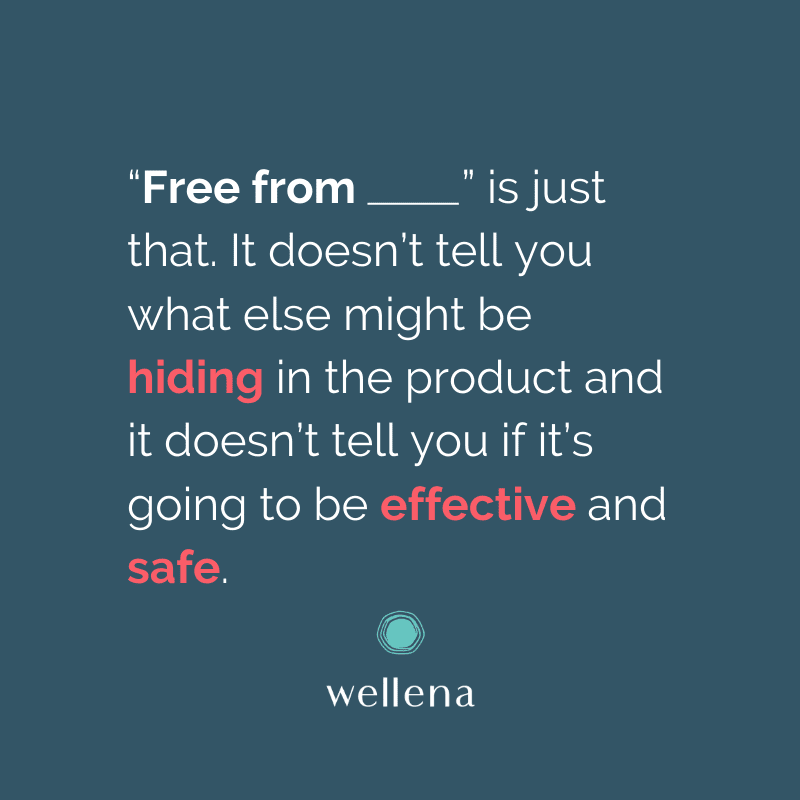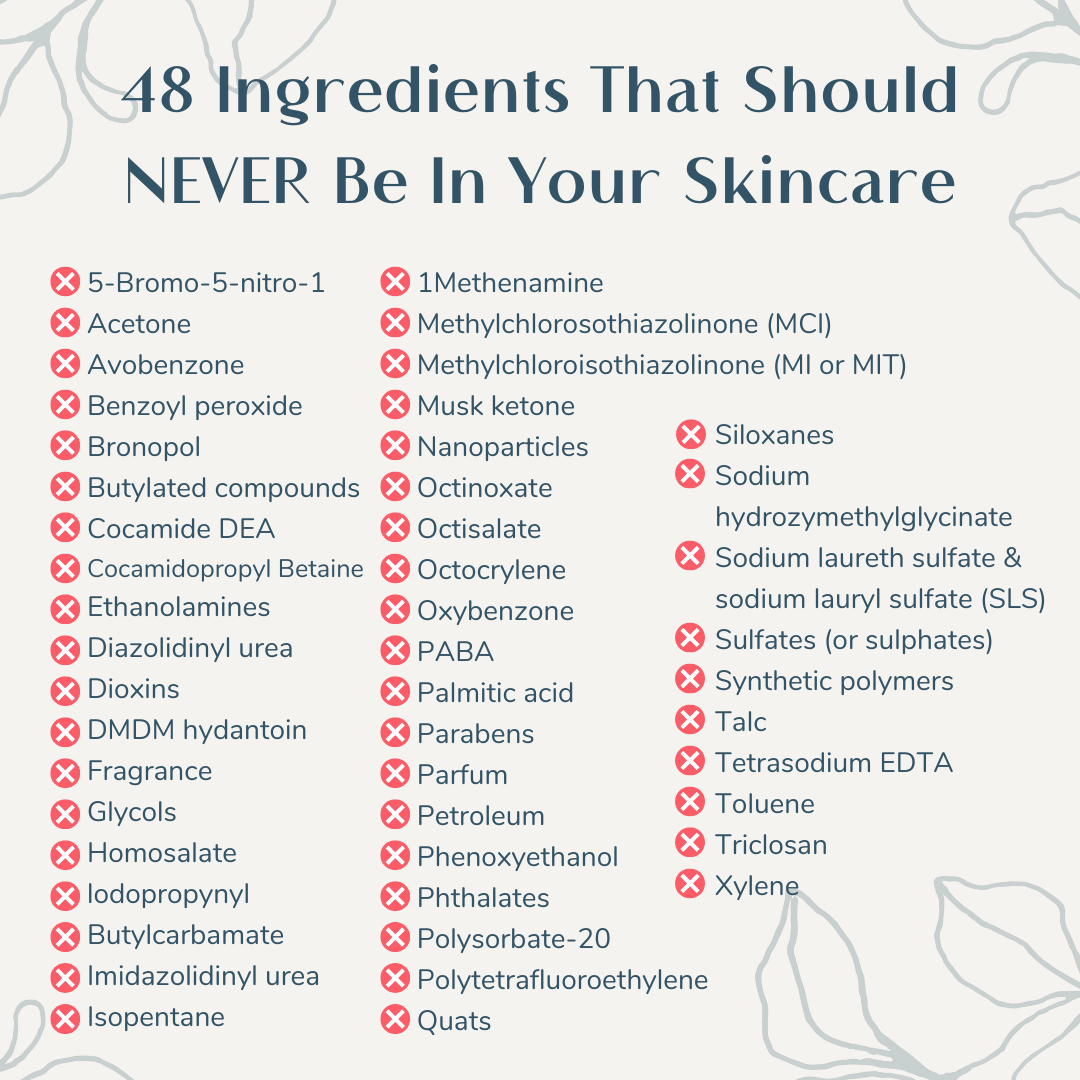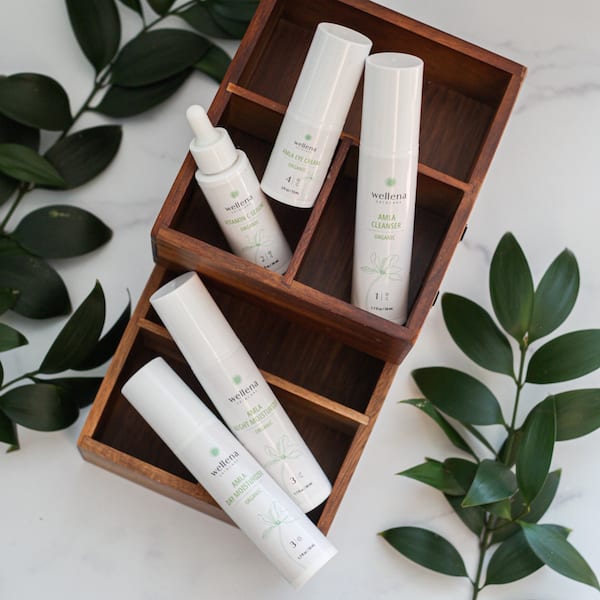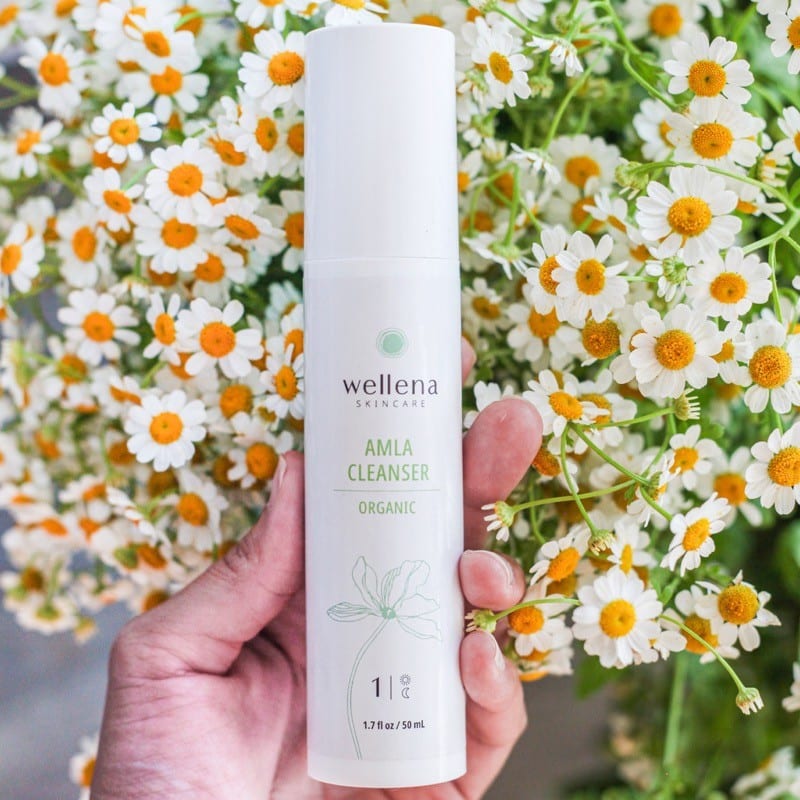What You Will Learn in This Article
- What is “Greenwashing”?
- Seven Sins of Greenwashing
- Why “Free from” Isn’t The Answer
- Offending Brands You May Know
- What Your Skincare Should Never Contain (Checklist)
- Why I Created My Own Skincare Line
What is Greenwashing in the Skincare Industry?
“Greenwashing” is the practice of falsely portraying a company as environmentally-friendly, safe and clean (as in “free of harmful chemicals”) for the sake of marketing. This applies especially to perceptions and claims pertaining to being environmentally friendly, natural, safe, organic, etc. Words like “green,” natural,” “eco-friendly,” “family farm” or “contains organic ingredients” are used to persuade the consumer that this is a safer, healthier choice. No testing or certification is required to make these claims on the label or on advertising pieces.
In fact, the U.S. Food & Drug Administration (FDA) admits on its website:
“Under the law, cosmetic products and ingredients do not need FDA premarket approval, with the exception of color additives.”
Even the Federal Trade Commission (FTC) recognizes this to be a problem. Their website states:
“A growing number of American consumers are looking to buy environmentally friendly, “green” products, from recycled paper to biodegradable trash bags. Companies have responded with “green” marketing touting the environmental benefits of what they’re selling. But sometimes what companies think their green claims mean and what consumers really understand are two different things.”

According to TerraChoice (now UL, as in “UL listed”) an advertising consultancy that keeps tabs on companies making “green” claims, there are Seven Sins of Greenwashing that companies may commit:
- The hidden trade-off — a product may be packaged in recycled plastic, but put cancer-causing ingredients into your body.
- No proof — Claiming “ethically sourced” or “made with organic ingredients” with no proof to back it up.
- Vagueness — Claiming “natural,” “eco-friendly” which have no real meaning and require no certifications.
- Worshiping false labels — Seals that look like the USDA seal and claim “organic” with no certifying body behind it.
- Irrelevance — “Triclosan-free toothpaste” as triclosan is no longer allowed to be added to toothpaste. Claiming “gluten free” on apple juice is another example – there would never be any gluten in apple juice.
- Lesser of two evils — Some things aren’t good, organically grown or not. For example: Regular consumption of large quantities of organic sugar can still give you diabetes.
- Fibbing — Falsely claiming to be organic, ethically sourced, etc.
A good example of the sin of the hidden trade-off is the “Free from” claim. I’ll explain more below.
Why “Free from” Isn’t the Answer to Safe and Clean
The European Union uses a “Free From” document as guidance for making cosmetics claims. There are certain “Free From” claims that aren’t allowed, such as a claim that a perfume is free from preservatives when it contains a high percentage of alcohol. The criteria for making acceptable claims are: legal compliance, truthfulness, evidential support, honesty, fairness, and informed decision-making. That sounds great, and it’s a great start — but it’s not the answer to getting safe and clean skincare.
When shopping for non-toxic or natural versions of our favorite beauty products, you may look for a product that is “Free from” many things such as:
- Paraben-Free
- Fragrance-Free
- Phthalate-Free
- Sulfate-Free
- Hydroquinone-Free
- Petroleum-Free
- Oxybenzone-Free
- Talc-Free
…And others, depending on your sensitivity and preferences.

However, just because a product is free from phthalates doesn’t mean it’s free from talc. “Free from ___” is just that. It doesn’t tell you what else might be hiding in the product (for example, petrochemical-based “mineral oil”) and it doesn’t tell you if it’s going to be effective.
Additionally, some companies will claim their products are free from ingredients that would never be included in the first place (Sin #5 Irrelevance, listed above). The company Arbonne is a prime example of this. It has a list of over 2,000 ingredients that are “NOT ALLOWED” in Arbonne products. That sounds hugely impressive… until you realize that the list includes things like barbiturates, anti-anxiety medications, Warfarin, and MSG—ingredients that shouldn’t be found in skincare products in the first place.
What Kind of Ingredients *Should* Be There?
After making sure your beauty products are “free from” all those harmful ingredients, what should be on the label? What types of ingredients should you be looking for? Some ingredients that are actually going to be beneficial for the skin include things like plant extracts and essential oils, good quality “fatty” or carrier oils (jojoba oil, shea butter or avocado oil are good examples), vitamins, minerals, and natural preservatives (such as rosemary essential oil, vitamin E, ethanol). Ingredients should be recognizable, or clearly given in their Latin name.
If you’re seeing a lot of those natural ingredients on a label and you don’t see any offending ingredients, you may think you’ve found a “winning” product. However, critical thinking is required here, because things are not always as they seem…
Offending Brands You May Know
These brands appear to be natural and/or organic, environmentally-friendly, and may make “free from” claims on their labels. They market themselves as clean and safe, but use untested chemicals that can cause poor reactions when used.
Melaleuca
Also known as “The Wellness Company,” Melaleuca is the perfect example of greenwashing. They claim to be all about health and wellness, but the ingredients labels on their products tell another story.
Take Sei Bella Refining Facial Cleanser as an example. Some of the standout ingredients in this particular product include Cocamidopropyl Betaine and parfum. Cocamidopropyl Betaine is a cleansing agent made by combining conventionally raised plant material (not organic) with the petrochemical Amidopropyl Betaine. Cocamidopropyl Betaine was named “Allergen of the Year” in 2004 by the American Contact Dermatitis Society.
Research since then has uncovered the impurities in the Cocamidopropyl Betaine that cause the allergic reactions. Side effects have included skin irritation, rashes, burning, itching, blistering, and even eye irritation.
Parfum is simply a term for added fragrance and can hide hundreds of synthetic chemicals, including phthalates. Phthalates are hormone-disrupting chemicals that are linked to low thyroid, fertility problems, certain cancers, and more. They can even ultimately lead to early menopause.
Offending ingredients: Cocamidopropyl Betaine and parfum
Jason Natural Products
Jason Natural Products are at most natural foods stores. Some of their popular products are their soaps, shampoos, and body washes. Unfortunately, the main cleansing ingredient used in these products is Sodium Myreth Sulfate. The process of making this ingredient involves use of the cancer-causing petrochemical, Ethylene Oxide, which then produces another cancer-causing ingredient, 1,4-Dioxane. This chemical then ends up in your body wash, ready to be absorbed through your skin.
Offending ingredients: Sodium Myreth Sulfate and Parfum
Nature’s Gate Organics
Nature’s Gate Organics is another so-called “organic” brand that is contaminated with questionable ingredients. The main cleansing ingredients in their soap and body wash produce lines are Disodium Laureth Sulfosuccinate (ethoxylated) and Cocamidopropyl Betaine –again, inflammation- and/or cancer-causing ingredients.
Offending ingredients: Disodium Laureth Sulfosuccinate (ethoxylated) and Cocamidopropyl Betaine.
Kiss My Face “Obsessively Organic”
Cocamidopropyl Betaine shows up yet again in Kiss My Face “Obsessively Organic” cleansers. Olefin Sulfonate is a petrochemical that has been added to the formulation. If you look up Olefin Sulfonate, you’re not necessarily going to find that it’s unsafe, simply that it’s made from petrochemicals, which, by definition, cannot be organic. That’s what makes this an “Organic cheater” brand.
Offending ingredients: Olefin Sulfonate and Cocamidopropyl Betaine.
And there are more…
In fact, four additional companies that claimed their products were natural were called out by the Federal Trade Commission in 2016. One example is SHIKAI’s “All Natural Hand and Body Lotion” and “All Natural Moisturizing Gel.” The lotion contains dimethicone, ethylhexyl glycerin, and phenoxyethanol. The gel contains phenoxyethanol. These ingredients are not by any means natural, with the most toxic ingredient of the three being phenoxyethanol.
According to the EWG, “Dimethicone (also called polymethylsiloxane) is a silicon-based polymer used as a lubricant and conditioning agent.” Definitely not an “all natural” ingredient. The Ethylhexylglycerin may cause dermatitis. Data is limited for both the dimethicone and the phenoxyethanol. However, we do know that there’s some evidence of phenoxyethanol as a skin irritant and nervous system toxicant.
When “Data is limited” according to the EWG, that doesn’t mean the ingredient is safe. It means that the ingredient is being used without much testing being done beforehand. That makes us the “guinea pigs.” Research may be done later after consumers complain of side effects or take action in the form of a lawsuit. This happens all the time with pharmaceutical drugs. They are released to the consumer and later on, after harm has been done, they are removed from the market.
And back in 2008, the Organic Consumers Association discovered carcinogenic petrochemical based ingredients in over 40 percent of the “natural” products they tested.
Third-Party Tested?
Check if your skincare products are tested by a third party to ensure they actually have the ingredients listed. Companies can choose to have their products third-party tested by sending the product to an organization like International, MADE SAFE, the Environmental Working Group (EWG), or best yet, a USDA certifying agency.
® INTERNATIONAL
It’s Quality Assurance International (QAI), a division of ® International, that provides the /ANSI certification for personal care products. Label claims are limited to “made with organic ____” with a 70% organic minimum. It does allow for some “nature-identical” synthetic preservatives but prohibits the use of petrochemicals in primary cleaning ingredients. It also allows for some hydrogenation and sulfation of product ingredients.
MADE SAFE®
Another certification is called MADE SAFE®. This organization is committed to ensuring safe ingredients in skincare. It requires its approved skincare companies and products to be free of all harmful ingredients known to cause harm to human health.
According to the website, “The MADE SAFE (Made With Safe Ingredients) seal literally means that a product is made with safe ingredients, without toxic chemicals known to harm our health.” Products that receive the MADE SAFE seal have passed screening for known:
✔ Behavioral toxins ✔ Carcinogens ✔ Developmental toxins ✔ Endocrine disruptors ✔ Fire retardants ✔ Heavy metals ✔ Neurotoxins ✔ High-risk pesticides ✔ Reproductive toxins ✔ Toxic solvents ✔ Harmful VOCs
EWG VERIFIED™
The Environmental Working Group has a EWG Verified list of products that have been found to be free of harmful chemicals. Its EWG VERIFIED™ mark indicates that the product:
✔ Avoids EWG’s ingredients of concern (EWG’s “Unacceptable” list)
✔ Provides full transparency (meets EWG’s standards for full disclosure, including fragrance ingredients)
✔ Uses good manufacturing practices (follows current good manufacturing practices)
USDA Certified Organic
USDA Certified organic is the ultimate third-party certification to have. This certification requires all products be:
✔ 95% organic ingredients in order to claim “Organic” and 70% organic ingredients to claim “made with organic ingredients”
✔ Free of synthetic preservatives and petrochemicals
✔ Free of hydrogenation and sulfation
The USDA National Organic Program (NOP) strictly enforces compliance with unannounced visits to the manufacturing facility.
Not All Ingredients Are Created Equal
You might see certain words on the ingredients list, like fragrance, chamomile, or bentonite clay and feel that you’ve found a clean product. Unfortunately, not all ingredients are created equal.
Natural vs. Synthetic Fragrance
For example, a “fragrance” included in your skincare product could be completely natural, a proprietary blend of high-quality, organically produced essential oils. (That will usually be clarified). However, if no explanation is given, and either “fragrance” or the French “parfum” is listed, you’re most likely going to be dealing with a blend of synthetic chemicals that are full of toxic constituents, like phthalates.
What is the Quality of the Essential Oils Used?
You may have read up on certain essential oils, like lavender or geranium and their benefits for the skin. Many skincare companies and products will highlight those ingredients on the label. However, as always, quality matters. If that particular essential oil is low quality (grown with pesticides, wrong harvest time, improper distillation time and/or pressure, etc) and hasn’t been tested to ensure certain levels of active constituents, you’re not going to get the results you’d hoped for.
According to a paper published on the National Association for Holistic Aromatherapy’s website, these are some things to watch for in suppliers when seeking out high-quality essential oils:
- Company is owned by someone with expertise in essential oils.
- Supplier focuses on producing oils for the professional aromatherapy market
- MS/GC spec report is available for each essential oil
- Safety data sheets (SDS) are available if needed
- Company has a close relationship with distillers
- Owner has been in the field for a long time and is highly respected by others in the field.
- Essential oils produced by the company include the common name, Latin name (exact genus and species), country of origin, part of plant processed, type of extraction (distilled or pressed), how it was grown (organic, wild-crafted, traditional) and chemotype (when relevant).
- Oils should be genuine (not altered) and authentic (from one specified plant)
Again, not all ingredients are equal.
What Your Skincare Should Never Contain
Here’s a printable checklist of what your skincare products should NEVER contain. You can also download it here.

If you’d like to learn more about the ingredients in skincare and whether they’re good, bad, or neutral, you may want to invest in this resource: A Consumer’s Dictionary of Cosmetic Ingredients by Ruth Winter.
Location, Location, Location
Do you know where the ingredients in your beauty/skincare products are sourced? Just like in real estate, it’s all about location. Many products and ingredients now come from overseas – especially China. The problem with that is that many ingredients that come from China have been found to contain high levels of heavy metals. I’ve already written about the dangers of toxic metals in the body.
Part of the issue with the sourcing location of ingredients is not only which country it’s from, but also, where in that country it’s grown. Was the plant grown near an industrial area, or was it grown in pristine forests or in clean mountain air?
It’s also important to know how a plant used for an essential oil or other ingredient was grown. After all, for an ingredient to be effective, it has to have been grown in such a way that the benefits are optimized. In order to get the optimal level of therapeutic constituents in the final product and limit the potential contaminants, the plant has to be given clean water and natural fertilizer and harvested at the right time of year and the right time of day.
Why I Created My Own Skincare Line
You may already know that in my “past life,” I used to work for an advertising agency, developing strategic plans for clients such as Neutrogena, L’Oreal, and Johnson’s Baby. I therefore intimately know the skincare world. Sadly, I saw a lot of its manipulation and ugliness.
Even after leaving the industry, I’ve been disillusioned by the rampant greenwashing and lack of truly natural, quality skincare products.
I know how hard it is to find skincare products that are clean, effective, and most importantly, that you love to use. So, I set out to make my own line: Wellena Skincare.
We now offer 6 essential products:
- Amla Cleanser
- Vitamin C Serum
- Amla Eye Cream
- Amla Day Moisturizer
- Amla Night Moisturizer
- Amla Renewal Cream

As you might have noticed, the rock star of this line is amla, also known as Indian gooseberry. Extremely high in vitamin C, amla offers serious benefits to our skin, including anti-inflammatory effects, cellular repair, collagen synthesis, skin protection from free radicals, and deep moisturization.
Some of the other great ingredients include:
- Aloe: Derived from the aloe vera plant, aloe is one of the most widely used plant compounds for soothing skin.It penetrates easily, leaving dry skin moisturized, and can even help calm skin inflammation.
- Soap nut: Have you heard of soap nuts before? They’re the dried shells from the soapberry nut, which contain a natural gentle soap called saponin. This nourishing soap is safe and effective on skin, and more friendly to the planet, too.
- Chamomile: Who hasn’t sipped on soothing chamomile tea to lull themselves into a restful sleep? It turns out, chamomile is just as effective at soothing and nourishing the skin. In our products, we use chamomile oil, which can relieve irritation and inflammation.
- Mango Seed Butter: This deeply moisturizing butter is derived from the natural fat in mango pits. As a rich emollient, mango seed butter nourishes the skin, leaving it supple, smooth, and firm. Mango seed butter is made up of a set of moisturizing fatty acids (including oleic, stearic, and linoleic) and nutrients like vitamin A, vitamin C, and vitamin E (hello, antioxidants).
- Shea Butter: You’ve likely used this hydrating emollient before. Shea butter is a fat that’s extracted from the nuts of the shea tree, most often found in West Africa. Like other plant butters, it contains moisturizing fatty acids (including oleic, stearic, and linoleic) that absorb readily into the skin. It also boasts high levels of vitamins A and E, meaning it’s an antioxidant powerhouse.
All our products are rooted in science. There’s no BS, just clean and honest ingredients that work. Our products are certified USDA Organic, and we use the cleanest, gentlest ingredients that nourish and repair the skin. These products are suitable for all skin types.
When you use our products, you can expect these benefits:
- Helps production of collagen
- Extremely high in vitamin C
- Overnight hydration
- Anti-inflammatory effects, cellular repair
- Soothing for the skin
- Emollient, deeply moisturizing
- Gluten-free
- Non-GMO
- No toxic preservatives
- No parabens
- No hydrogenated oils
- No artificial colors or fragrance
Want to try Wellena Skincare? Get the Cleanse + Nourish Kit

If you’d like to try our natural product line for yourself (and support us in our new launch), the Cleanse + Nourish Kit is a great option.
The Amla Cleanse + Nourish Kit makes your routine clean and easy, with certified organic ingredients known to gently cleanse and boost collagen levels. It includes full sizes of our:
- Amla Cleanser: Gentle and effective, our gel cleanser boasts high concentrations of antioxidant vitamin C, thanks to the superfruit amla. An organic soap derived from soap nuts provides gentle cleansing without stripping the skin of its natural oils. This cleanser is completely free of irritants, sulfates, or harsh chemicals.
- Amla Night Moisturizer: Loaded with rich hydration, this formulation increases skin elasticity, firmness, removes puffiness under the eye, and reduces fine lines and wrinkles. It’s an uber-nourishing nightly treatment.
- Amla Eye Cream: Specially formulated to increase skin elasticity and firmness, remove under-eye puffiness, reduce fine lines and wrinkles, moisturize, nourish and brighten the skin’s appearance.
You can try our Wellena Cleanse + Nourish Kit here.
Bottom Line…
Start looking at the back of the product label, not just the front. Remember, the front label is there to persuade you to buy that product. The back label (where the ingredients are listed) is there to inform you about what might be in that product, but remember that’s just a starting place. Use our tips above and your own critical thinking to find clean and healthy products to truly nourish your skin.
Resources
Dahl, R. Green Washing: Do you know what you’re buying? Environmental Health Perspectives. June, 2010.
TerraChoice. Sins of Greenwashing. UL LLC website. Accessed March 12, 2020.
Eidinger, A. Dr. Bronner’s Magic Soaps Files Lawsuit Against Major ‘Organic’ Cheater Brands. Organic Consumers Association. April 28, 2008.
Federal Trade Commission. “Truth in Advertising: Green Guides.” Accessed March 19, 2020.
U.S. Food & Drug Administration. FDA Authority Over Cosmetics: How Cosmetics Are Not FDA-Approved, but Are FDA-Regulated. Accessed March 19, 2020.
The Ultimate Guide to Clean Beauty. Harper’s Bazaar.
Jacob, S.E. & Amini, S. Cocamidopropyl betaine. Dermatitis. May-June, 2008.
. /ANSI 305: Organic Certification for Personal Care Products. Accessed March 15, 2020.
Dallmeier, L. Important 2019 Changes to EU Free From Claims. Formula Botanica website. Accessed March 19, 2020.
Shutes, J. The Quality of Essential Oils Journal. National Association for Holistic Aromatherapy website. Accessed April 1, 2020.

Can you send a list of body lotions that are good to use? Do you sell a body lotion?
Hey Patricia,
We do not sell a body lotion at this time, but if you are interested in making your own, check out our Herbs For Balance program that offers lots of DIY recipes.
https://hormonesbalance.com/hfb/join/
Healthy Regards,
HB Team
Hi Patricia,
Please check out https://hormonesbalance.com/allthingswelove/ for brand recommendations. =)
You may also be interested in checking out our Herbs For Balance program, where we give lots of great recipes to make your own products at home. https://hormonesbalance.com/hfb/join/
Healthy Regards,
HB Team
On the list of ingredients to avoid, retinoids is listed. Why is that? Isn’t that the only proven ingredient for wrinkles? And why is it bad? What should be used in stead?
Hi Helene,
Retinoids are actually not on our list of 45 ingredients to avoid. However, if you are looking for products that may help prevent wrinkles, take a look at our Vitamin C serum, as collagen is an important factor in preventing wrinkles.
Healthy Regards,
HB Team
When are you going to sale your products in Canada.
I wish I can order some of these skin care products and some other products you have but I live in Canada.
Hi Elizabeth, there is a resource for shipping internationally called MYUS.com. If you use them, you, of course, do so at your own risk. That said, one of our colleagues shipped the Wellena to her home in Canada using this service, and had a good experience.
Healthy Regards,
Sarah
Hi there, in This article you claim that Avalon organics has a certain ingredient in their shampoo Cocamidopropyl Betaine and I am looking through the ingredients of the shampoo and conditioner that I use I do not see that ingredient. I use EWG to look up ingredients in all of my products because I am allergic to a lot of stuff. Avalon organics is EWG verified which is what you promote at the end of the article. I’m not sure if the article needs to be updated but I feel like list Avalon organics on here is contradictory if you’re promoting EWG verified products, which all of theirs are. That would be really very confusing to someone who is not well-versed in this topic. Please consider updating your list. Thank you!
Hi Laura, I’ll passed this onto my team for review. We appreciate you pointing this out, because it does include two different viewpoints on the topic. Thank you. ~HB Support